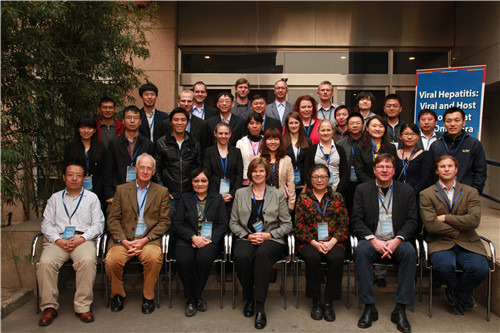Sino-German workshop "Viral hepatitis: viral and host genomics at the omics era" was held and sponsored by Sino-German Center for Research Promotion in National Natural Science Foundation of China (NSFC) during Oct 18th-19th, Prof. ZENG Changqing from Beijing Institute of Genomics(BIG) and Prof. Ulrike Protzer from Technische Universit?t München co-hosted the symposium. In total, 40 scientists from 22 institutions of China and Germany participated this symposium. German delegation consisted of 16 scholars and China side contain 24 scientists. This Symposium successfully invited many leading scientists in field of viral hepatitis. For instance, four Germany delegates were the section chairs of the International Meeting on Molecular Biology of Hepatitis B Viruses in either this year or recent years. Among them, the German host and the director of Virology at Technische Universit?t München, Prof. Ulrike Protzer is a specialist for Internal Medicine focusing on hepatology and infectious diseases, and she is one of the leading scientists on novel immune therapy for chronic HBV infection. Prof. Michael Roggendorf from the University of Duisburg-Essen is a well-known scientist on therapeutic vaccine development and has attended almost every International Meeting on Molecular Biology of Hepatitis B Viruses. He also was the initiator and spokesman of the first German-Chinese collaborative research center (SFB) in life sciences. Prof. Dieter Glebe from University of Giessen, is the head of the National Reference Centre for Hepatitis B and D viruses of Germany since 2011. He established a widely adopted system for the study of HBV infectivity and pathogenicity based on the primary culture of Tupaia hepatocytes. Prof. Stephan Urban from the University of Heidelberg, has been one of the pioneers for the identification and analysis of molecular components involved HBV entry. His achievements in cell and animal models have become fundamental for the research on virus-host interaction. In Chinese delegates, Prof. WEN Yumei is an academician of Chinese Academy of Sciences and has been recognized as one of the pioneers in field of therapeutic vaccines based on hepatitis B surface antigen-antibody complex. Especially, Prof. LI Wenhui, whose recent identification of NCTP as the HBV receptor in host cells is a great contribution to the field of viral hepatitis, also attended this symposium and presented his updated receptor study results. Prof. YUAN Zhenghong, the major organizer of this year's International meeting on Molecular Biology of Hepatitis B Viruses, also presented their progresses recently published on Hepatology and Nature Immunology. At the end of the workshop, many participants of both parties expressed their comments and enjoyment for the high profile and excellent presentations of this symposium. China has the largest population of viral hepatitis patients. The medication for the viral infection and caused diseases is crucial for the public health. Meanwhile, viral hepatitis is a major cause of hepatocellular carcinoma. Therefore, it is vital to reveal the molecular mechanism of viral hepatitis and carcinogenesis after infection. As shown in this symposium, the major research focuses of Chinese scientists, who have made a series of progresses in recent years, include viral mutation analysis and drug resistance, the host susceptibilities for viral hepatitis and liver cancer, the development of therapeutic vaccine, and the strategy for diagnosis and medication. All of these research and achievements raise great needs and opportunities for Chinese scholars to further communicate and collaborate with world leading scientists in the field. Germany is a pioneer country in viral hepatitis research and has formed a characteristic research system including cell and animal models for functional analyses of HBV. German scientists have contributed largely to virus and host factors during the infection, the natural history of viral infection, and virus induced carcinogenesis. In this symposium, German and Chinese scholars shared their research progresses and opinions on diversities of viral genomes, changes in host immune system, viral-host interactions, novel therapeutic strategies and molecular mechanism underlying the development of HCC during chronic infection, etc. This greatly promoted the communications among scientists from both sides, laying a good foundation for further collaborations. Also, the rapid development of “omics” technologies for genome-wide analyses provides a great opportunity to explore HBV pathogenesis and to update our understanding in this field. Group photo of scientists(Image by SUN Mingyuan)
